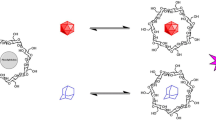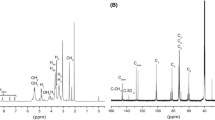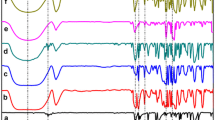Abstract
Complexation of some o-, m- and p-carborane derivatives with β-cyclodextrin was investigated using phenolphthalein in pH 10.5 (0.05 mol dm−3) borate buffer. Some carborane derivatives indicated large inclusion constants Kass > 1 × 105 dm3 mol−1.
Similar content being viewed by others
Avoid common mistakes on your manuscript.
Introduction
Carboranes (dicarba-closo-dodecaboranes) have been intensively studied as compounds used for boron neutron capture therapy of cancer [1]. Large number of such compounds bearing carboxylic, hydroxyl, amino and other groups [2–4] have been synthesised. Carboranes themselves are nonpolar compounds highly insoluble into water. Introduction of hydrophilic groups into carboranyl residue increases the solubility of such compounds in the water. Cyclodextrin can also be used to increase the water solubility of such compounds. Formation of inclusion compound of o-carborane (1,12-dodecaborane) with β-cyclodextrin has been reported earlier [5]. No data of inclusion constants were presented. Recently Ohta [6] ea. estimated complexation of β-cyclodextrin with o-carboranols from NMR titration studies. We report about complexation of some o-, m- and p-carborane derivatives with β-cyclodextrin.
Experimental
Solution of carborane derivative in methanol was mixed in volumetric flasks with an aqueous solution of β-cyclodextrin (“Fluka”) and solvent was evaporated to dryness under reduced pressure. In order to prevent sublimation of carboranes, some amount of pure carboranes was added into desiccator. A 0.05 dm−3 borate buffer (“Fluka”) solution pH 10.5 containing phenolphthalein (“Aldrich”) solution were added to the dried residue. Concentration of phenolphthalein was kept constant 3.0–3.5 × 10−5 mol dm−3, concentration of cyclodextrin was kept in range up to 2–4 × 10−4 mol dm−3. Each experiment was repeated at least 6 times.
Investigation of complexation of carboranes with cyclodextrin was carried out at 25 ± 0.1 °C spectrophotometrically (“Kontrum”) measuring absorbance of the solution containing both complexed and liberated phenolphthalein at 553 nm. Association constant of phenolphthalein was Kass = 3.4 × 104 dm3 mol−1, similar to the reported earlier [7]. Association constant of the complex of β-cyclodextrin and carborane can be calculated from the Eqs. 1–4:
Where Kass is the association constant of the complex with carborane, C0 and C concentration of initial and complexed cyclodextrin respectively, B0 initial concentration of carborane.
Concentration of complexed cyclodextrin C can be calculated from the Eq. 2:
where Kdiss is the dissociation constant of β-cyclodextrin and phenolphthalein complex, P0 and P are concentration of initial and complexed phenolphthalein.
Concentration of complexed phenolphthalein P can be found from the Eq. 3:
where ΔA and Δε are the difference in absorbance and molar extinction of phenolphthalein by addition of carborane.Then
The value of Δε can be found according to the Benesi–Hildebrand method [8] from the slope of the line [CD] × [Guest]/ΔA against [CD] + [Guest].
1H-NMR investigations were carried out on Varian 400 MHz spectrometer. d21-β-Cyclodextrin was prepared by evaporating D2O (“Fluka”) from the solution of β-cyclodextrin. Prepared d21-β-cyclodextrin was dissolved in D2O containing 0.1 mol dm−3 of NaOD (“Fluka”). o-Carboranyl propionic acid, dissolved in 0.1 mol dm−3 of NaOD solution, was added.
Results and discussion
Carborane derivatives (Fig. 1) were synthesised from o-, m- and p-carborane (1a, 2a and 3a respectively) according to the procedure presented in [9].
Appropriate carborane was treated with butyl lithium followed by alkylation of tert-butylmethylsilyl chloride. Then the intermediate compound was treated with butyl lithium and trimethylene oxide. The hydroxyl group was deprotected by tetra-n-butylammonium fluoride. Appropriate o-carboranyl propionic acid [3-(1,2-dicarba-closo-dodeca-borane(12)-1-yl)-2-propanoic acid] (1c), m-carboranyl propionic acid [3-(1,7-dicarba-closo-dodeca-borane(12)-1-yl)-2-propanoic acid] (2c) and p-carboranyl propionic acid [3-(1,12-dicarba-closo-dodeca-borane(12)-1-yl)-2-propanoic acid] (3c) were prepared by oxidation of obtained o-, m- and p-carboranyl propanols (1b, 2b and 3b respectively) (see Fig. 2). All experimental details of the synthesis of carborane guests are presented in [9].
The inclusion constants of cyclodextrin and carborane derivatives were obtained using competitive method of inclusion with phenolphthalein [10–12]. This is simple method of determination of inclusion constants if the substrate remains stable in slightly alkaline media (pH 10.5). Cyclodextrin forms quite strong inclusion complex with phenolphthalein. When the concentration of the host (cyclodextrin) exceeds one of the guests more than 10 times, the colour of phenolphthalein almost disappears. We measured absorbance at the peak of it at 553 nm. The colour comes out when the competitive guest is added. The new guest (carborane) occupies the place of phenolphthalein and forms inclusion complex with the host (cyclodextrin).
Our test approved that carborane derivatives were stable in the alkaline media, so the competitive method was suitable for determination of inclusion constants. No decolorisation of phenolphthalein solution under such conditions (pH 10.5) was observed. As it was recently indicated [13] the pK a value of ionisation of β-cyclodextrin equals to 13.5. Only a little fraction of β-cyclodextrin is ionised under such pH value, thus it does not influence results of our investigations.
By varying the concentration of carboranes the visible spectra of liberated phenolphthalein was recorded. Absorbance value at 553 nm has been taken for calculations of complexation constants according to the Benesi–Hildebrand method [8].
Results are given in Table 1.
According to our observations, introduction of hydrophilic groups to the moiety of carboranyl generally increases the association of highly lipophylic carborane cage. In comparison, negatively charged dodecaborane cage (4) has very low inclusion constant. In some cases the association constants reaches the magnitude of 105 dm3 mol−1, which is larger than the one of phenolphthalein itself. Constants of inclusion of 3-carboranyl-1-propanol (1b, 2b and 3b) derivatives are rather similar in all cases. Introduction of methyl group to o-carboranyl rim in 3-carboranyl-1-propanol (1d) causes the increase of nonpolar properties of this compound, and therefore a large constant of inclusion was found. Inclusion of 3-carboranyl-propanoates increases in order from o- to p- carborane derivatives. In our opinion, this also depends on increase of nonpolar properties of carboranyl residue. Observed inclusion constants belong to the group of comparatively large constants of cyclodextrin [14]. This approves that carborane derivatives show high affinity to the cyclodextrin cavity.
In order to analyse the structure of inclusion complex a 1H-NMR investigation of inclusion of 3-m-carboranyl-propanoic acid to cyclodextrin was carried out. Carboranyl-derivative was added to the alkaline solution and spectra 1H-NMR was recorded. No significant chemical shift of both methylene groups of propanoate residue of carborane derivative was observed. At the same time, chemical shift of peaks of 1H atom attached to carbon atoms of internal rim of β-cyclodextrin C-3 (from 3.79 to 3.72 ppm) and C-5 (from 3.70 to 3.65 ppm) indicated that carboranyl residue penetrated to cyclodextrin cavity forming inclusion complex while ionised propanoate residue remained outside the rim.
Carboranes form comparatively strong molecular complexes with cyclodextrin. This effect might be important for transportation of such chemicals in the blood system.
Results of this investigation of complexation of carboranes to cyclodextrin might be used for further studying formulation of pharmaceuticals.
References
Barth, R.F., Coderre, J.A., Vicente, M.G.H., Blue, T.E.: Boron neutron capture therapy of cancer: current status and future prospects. Clin. Cancer Res. 11, 3987–4002 (2005)
Ujváry, I., Nachman, R.J.: Synthesis of (S)-3-(1-hydroxy-p-carboran-12-yl)alanine, a novel hydrophobic tyrosine-mimetic for peptides. Peptides 23, 795–799 (2002)
Lindström, P., Naeslund, Ch., Sjöberg, S.: Enantioselective synthesis and absolute configurations of the enantiomers of o-carboranylalanine. Tetrahedron Lett. 41, 751–754 (2000)
Tjarks, W., Ghaneolhosseini, H., Henssen, C.L.A., Malmquist, J., Sjöberg, S.: Synthesis of para- and nido-carboranyl phenanthridinium compounds for neutron capture therapy. Tetrahedron Lett. 37, 6905–6908 (1996)
Harada, A., Takahashi, S.: Preparation and properties of inclusion complexes of 1,2-dicarbadodecaborane (12) with cyclodextrins. J. Chem. Soc. Chem. Commun. 20, 1352–1353 (1988)
Ohta, K., Konno, Sh., Endo, Y.: Complexation of β-cyclodextrin with carborane derivatives in aqueous solution. Tetrahedron Lett. 49, 6525–6528 (2008)
Okuba, T., Kuroda, M.: Inclusional dissociation of phenolphthalein with cyclodextrin in the presence of polyelectrolytes and ionic detergents as studied by the temperature-jump technique. Macromolecules 22, 3936–3940 (1989)
Benesi, H.A., Hildebrand, J.H.: A spectrophotometric investigation of the interaction of iodine with aromatic hydrocarbons. J. Am. Chem. Soc. 71, 2703–2707 (1949)
Naeslund, Ch., Ghirmai, S., Sjoberg, S.: Enantioselective synthesis of m-carboranylalanine, a boron rich analogue of phenylalanine. Tetrahedron 61, 1181–1186 (2005)
Shu, F.L., Connors, K.A.: Complex formation between α-cyclodextrin and 4-substituted phenols studied by potentiometric and competitive spectrophotometric methods. J. Pharm. Sci. 72, 1333–1338 (1983)
Hirsh, W., Choy, Ch.K., Wog, K., Fried, V.: Determination of cyclodextrin-guest association constants by competition with indicator dyes. Anal. Lett. 22, 2861–2869 (1989)
Cadena, P.G., Oliveira, E.C., Araujo, A.N.,. Montenegro, M.C.B.S.M., Pimentel, M.C.B., Filho, J.L.L., Silva, V.L.: Simple determination of deoxycholic and ursodeoxycholic acids by phenolphthalein-β-cyclodextrin inclusion complex. Lipids 44. http://www.springerlink.com/content/2p8660851508v686. (2009)
Gaidamauskas, E., Norkus, E., Crans, D.C., Grinciene, G.: Deprotonation of β-cyclodextrin in alkaline solutions. Carbohydr. Res. 344, 250–254 (2009)
Connors, K.A.: The stability of cyclodextrin complexes in solution. Chem. Rev. 97, 1325–1358 (1997)
Author information
Authors and Affiliations
Corresponding author
Rights and permissions
About this article
Cite this article
Vaitkus, R., Sjöberg, S. Large inclusion constants of β-cyclodextrin with carborane derivatives. J Incl Phenom Macrocycl Chem 69, 393–395 (2011). https://doi.org/10.1007/s10847-010-9768-6
Received:
Accepted:
Published:
Issue Date:
DOI: https://doi.org/10.1007/s10847-010-9768-6






